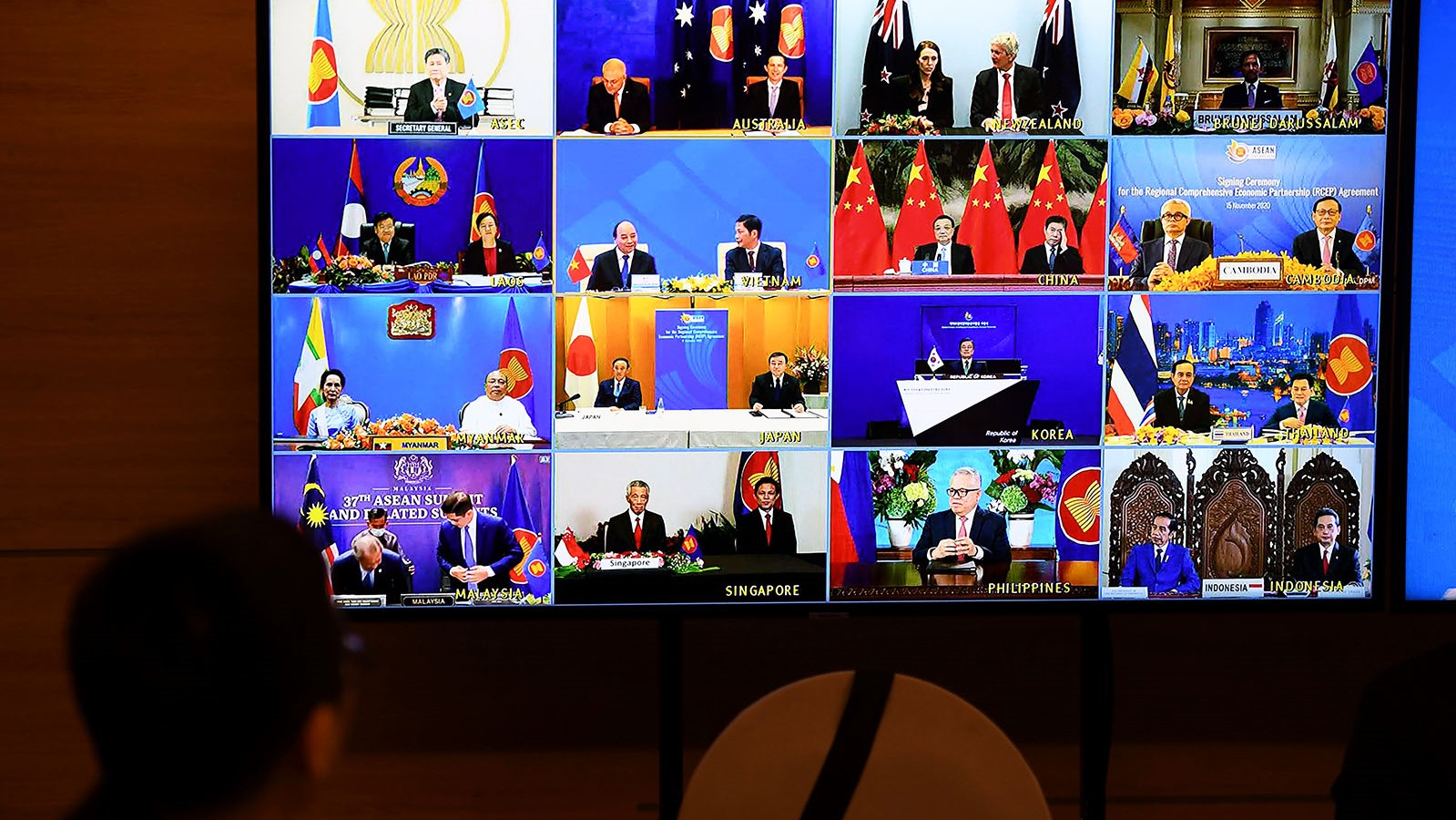Hopes are high as paper-based trade moves towards digitization despite fraught and halting progress. The United Nations Conference on Trade and Development (UNCTAD) estimates that global trade in goods and services reached a record high of US$28.5 trillion in 2021, an astounding figure considering the world was just starting to reopen as the pandemic waned – astounding also because the everyday challenge of moving shipments of goods across borders is largely invisible even to those on the receiving end at ports, factories, stores, mailboxes, and front porches.
Documentation is among the major constraints. Depending on origins or destinations, it can take reams of pages of documents – in some instances, up to 30 or more from separate agencies – to clear customs, let alone obtain financing, insurance, and space on ships, planes, and overland vessels. Even multinational corporations (MNCs), with backoffice resources to produce the documents, can struggle resulting in myriad delays.
The operative word here, unfortunately, is ‘pages’ – as in parchment. Most of these documents are still hard copies, ranging from bills of lading (B/Ls) and country-of-origin certificates to invoices and letters of credit. Often, they must be filled in – sometimes by hand, then signed and/or ‘wet stamped’ by an official seal, held and filed, copies returned to various intermediaries in transit, and then all checked by officials on both sides. The Paris-based International Chamber of Commerce estimated that these processes result in around four billion trade-related paper documents in circulation at any point in time.[1]
The Digital Container Shipping Association, an industry body, said in a 2020 report that the volume of paper B/Ls alone incurs US$11 billion in trade expenses each year.[2] The Commonwealth Secretariat, which serves the 56-member association of former British colonies, put the overall cost per transaction of using paper trade at US$81,000. Not only does this slow the flow of goods, but the associated costs dissuade, if not completely cut off, many smaller businesses from international markets.
So at a time when, to borrow from John Maynard Keynes, who remarked on how the telephone revolutionized global trade, a woman sitting at her desk in an office in Tokyo can order products from all over the world with a few clicks on her smartphone and reasonably expect them to be at her door when she arrives home, the firms that make that possible today still have to deal with a largely antiquated system by comparison.
Efforts have been underway for some time to remedy this by codifying trade digitization into international law, which sets out to provide nations with a template of rules they could legislate. This began with the UN Commission on International Trade Law’s (UNICTRAL) 1996 Model Law on Electronic Commerce (MLEC). Trade digitization – as opposed to digital trade, which is the cross-border flow of data as a good (think online streaming services) – is the use of digital platforms and software to obviate the need for paper. Since the Model Law, UNICTRAL has introduced other trade facilitation principles, including one covering the legality of e-signatures in 2001, and another on electronic transferable records in 2017.[3] More recently, an alphabet soup of other international organizations, industry bodies, and regional and bilateral groupings have been tabling overlapping sets of initiatives and standards alongside UNICTRAL’s ongoing work.
Some form of harmonization that will be adhered to is necessary. Harmonization is trade speak for the adoption of a single set of standards, rules, measures, and qualifications.[4] Failing that, the whole endeavor will likely create only a different set of constraints on trade – shiny new vessels for e-commerce, but constraints nonetheless on global trade facilitation.
And therein lies the rub for trade digitization.
Hesitation at the water’s edge
Harmonization is a persistent problem in trade; the negotiations therein among the most laborious.[5] The compromises struck by global trade negotiators to achieve it so far venture only to the edge of sovereignty, or what their vested domestic interests allow. Sanitary and phyto-sanitary rules, which cover health and safety protocols, particularly for animals, food, and pharmaceuticals, are among the most contentious when it comes to harmonization. To the extent agreements on SPS exist, whether at the World Trade Organization or in regional or bilateral trade deals, they are honored as much as breached in practice.[6]
To the credit of all parties involved, harmonization in trade digitalization has been progressing albeit haltingly. Currently, there is no single source of up-to-date information regarding which countries have ratified, implemented, and enforced any of UNICTRAL’s Model Laws. UNICTRAL provides lists of countries that have passed legislation that is “based on or influenced by” the Model Laws, but it appears to be incomplete and is littered with qualifying notes. Take Singapore and e-signatures: Singapore is not listed among the 38 states in UNICTRAL’s list. Yet it clearly belongs, having amended an existing law on the use thereof in March 2021, which now expressly comports with the Model Law on Electronic Transferable Records (MLETR).[7] This is unlikely to be the only instance of a country where such legislation is either not notified or overlooked.
Network of networks (of networks of networks)
Agreeing, ratifying, and fully implementing a set of global governing standards on trade digitization seems fanciful, especially at a time when the one body which might otherwise be able to enforce such an objective, the WTO, is beset by problems. Instead of a ubiquitous, globe-spanning digitization platform, expectations have been tempered for the emergence of a “network of networks,” says Andrew Balgarnie, chief revenue officer of TradeWindow, a New Zealand-based digital solutions provider for exporters, importers, and freight forwarders. Private sector firms like TradeWindow aim to provide the glue that binds these networks, as do financial institutions that provide trade and receivables finance, maritime insurers, and the governments which ultimately control the flow of goods and services across borders.
At the regional network level, there have been some encouraging developments in recent years. The 2020 Digital Economy Partnership Agreement (DEPA) is one. Initiated by Singapore, Chile, and New Zealand – the same P+4 group of economies, sans Brunei, that founded the Comprehensive and Progressive Agreement for Trans-Pacific Partnership – DEPA covers vital aspects of digital trade facilitation, including stipulations that:
- Each party shall accept electronic versions of trade administration documents as the legal equivalent of paper documents (Article 2.2.3).
- Each party shall maintain a legal framework to adopt the UNICTRAL Model Law on Electronic Transferable Records … and shall endeavour to avoid imposing any unnecessary regulatory burden on electronic transactions (Article 2.3.2 and 2.3.3).[8]
The agreement contains other provisions relevant to digital trade facilitation too numerous to detail here. Importantly, however, as with the P+4 agreement, DEPA features accession protocols (Article 16.4), meaning its membership can expand, provided applicants do so “on terms agreed among the Parties.” Already, China, of all countries, has applied for membership (more on China below) and an Accession Working Group formed.[9] South Korea quickly applied for observer status and since then an Accession Working Group also been formed to consider its application. Canada, too, has expressed strong interest in joining.[10][11] Others are sure to follow, as continues to happen with the CPTPP; the United Kingdom being the most recent candidate.
DEPA is unique in that it’s a first-of-its-kind agreement focused solely on digital trade, but recent trade agreements have contained separate chapters covering the topic, even if the language of the actual provisions therein is not as concrete or binding as DEPA, allowing for more wiggle room. The CPTPP, perhaps the most prominent such agreement, dedicates a chapter (Chapter 14) to Electronic Commerce and Article 14.6 covers ‘Electronic Authentication and Electronic Signatures.’ It does, however, give signatories a way out, with language maintaining that provisions are dependent on accordance with [national] law. That can mean just about anything, rendering the preceding provisions somewhat toothless.
The UK-Australia free trade agreement (FTA) is even weaker, asking only that the parties ‘shall endeavour to avoid any unnecessary regulatory burden on electronic transactions’ and to ‘facilitate input by interested persons in the development of its legal framework for electronic transactions.[12] The UK, which has a strong legal framework in place for electronic transactions, is far less to blame for the open language here than Australia, which has so far exercised more caution in this area and cross-border data flows in general. The language in the Regional Comprehensive Economic Partnership (RCEP), a major regional agreement among the 10 member states of the Association of Southeast Asian Nations and five other countries with which it had separate existing FTAs, is looser yet in this regard.
More encouragingly, there are countries, like the UK and Singapore, that are taking unilateral legislative steps to advance trade digitization. The US is the latest to do so. In July, it amended its Uniform Commercial Code (UCC), an ostensibly federal statute, to address a host of issues
related to trade digitization, including digital records, e-signatures, electronic negotiable instruments, and hybrid transactions (those that involve both goods and services.)[13] Given the US’ influence and importance to international trade, one would hope this would have a cascading effect on its partners. But for that to happen, the UCC measures need to be adopted by individual states in the US, a process bound to take longer.[14]
Discordant notes
Governance of cross-border data flows is exceedingly contentious and will be a defining issue of trade for the foreseeable future. Ian Bremmer, Chief Executive Officer of the Eurasia Group consultancy, has called for the establishment of a World Data Organization, akin to the World Trade Organization.[15]
Short of such ambition, the ‘network of networks’ might be the next best solution for something approaching harmonization in trade digitization. Even that is going to prove difficult, however. More countries are becoming protective of their citizens’ personal and financial data, the data stored by the companies that operate within their jurisdictions, and the websites its residents can access.
China and its ‘Great Firewall’ is, of course, the prime example here, though just about every country in the world imposes data restrictions that ultimately inhibit harmonization in this area, says Inga Morton, general manager at International Port Community Systems Association, an organization of sea and airport operators. Australia, for one, has been cited above, though not because it cordons its citizenry off from the internet in the same manner as China; rather because of its tightening data localization requirements.
And then there’s Europe and its General Data Protection Regulation (GDPR), along with more targeted policies within the EU member states themselves. There are others as well, including the US, making the differences between these disparate platforms potentially irreconcilable.
But the search to strike a fine balance between data privacy and commercial interests is certainly on. It may not be enough for global harmonization of trade digitization. Unless and until that compromise is found, however, firms will be stranded astride a line, one foot stuck in the past and one edging to the future.
The author would like to thank Phil Levy of Flexport, Andrew Balgarnie of TradeWindow, and Inga Morton of IPSCA for their input. Where not directly quoted, the views expressed reflect those of the author alone.
***
[1] https://www.britishchambershanghai.cn/content/media/2021/11/ICC-UK-Creating-a-Modern-Digital-Trade-Ecosystem.pdf (This figure is quoted in any number of reports that could be footnoted here).
[2] https://go.dcsa.org/ebook-ebl/
[3] https://uncitral.un.org/en/texts/ecommerce
[4] For a definition, see Dictionary of Trade Policy Terms, WTO, Fourth edition, Walter Goode.
[5] Ibid.
[6] SPS disputes rank sixth among the types of disputes brought before the WTO from its founding to when the Appellate Body ceased to function in 2020, but that number does not include the many SPS disputes brought under its predecessor General Agreement on Trade and Tariffs. See here: https://www.wto.org/english/tratop_e/dispu_e/dispustats_e.htm
[7] https://www.aseanbriefing.com/news/electronic-signatures-in-singapore/
[8] For full text of the agreement see here: https://www.mfat.govt.nz/assets/Trade-agreements/DEPA/DEPA-Signing-Text-11-June-2020-GMT-v3.pdf
[9] https://www.mti.gov.sg/Newsroom/Press-Releases/2022/08/Digital-Economy-Partnership-Agreement-Joint-Committee-commences-Accession-Working-Group-for-China
[10] https://www.international.gc.ca/trade-commerce/consultations/depa-apen/background-information.aspx?lang=eng. South Korea has already been granted observer status.
[11] http://m.koreaherald.com/view.php?ud=20220127000191
[12] https://www.dfat.gov.au/trade/agreements/not-yet-in-force/aukfta/official-text/australia-uk-fta-chapter-14-digital-trade See: Chapter 13, Digital Trade, Article 14.4 13 https://www.txfnews.com/articles/7418/Summer-steps-forward-for-US-and-global-trade-digitisation-Prepare-to-swoon
[14] Ibid.
[15] https://www.gzeromedia.com/why-we-need-a-world-data-organization-now
© The Hinrich Foundation. See our website Terms and conditions for our copyright and reprint policy. All statements of fact and the views, conclusions and recommendations expressed in this publication are the sole responsibility of the author(s).





